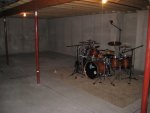WayneWickman
Senior Member
I recently moved to a new construction house and am lovin' having the entire unfinished basement as my studio. The acoustics are great, just me and my kit in a 1700 sq ft concrete box. Great natural reverb, when I distant mic I can almost get that "levee" sound. But....all good things must come to an end. No matter how hard I try I can't get the wife to let me have the whole basement. So in the end I get a 15X17' drum/recording room to do what I wish. My question; Does anyone have any references, books, links, anything to get the most out of this room? I'm starting from scratch so basically anything is possible. Some ideas I have so far...Make my walls 2X6" and insulate the hell out of it, including ceiling. I'm a wood guy so I would like hardwood floors, oriental rug for the kit. I would like to do tongue and groove wood walls or paneling but that might be too reflective for such a small room; but I could overcome that by using acoustic panels. Currently for most applications I close mic my kit.
Any direction would be much appreciated.
Wayne
attached is my current studio....
Any direction would be much appreciated.
Wayne
attached is my current studio....


